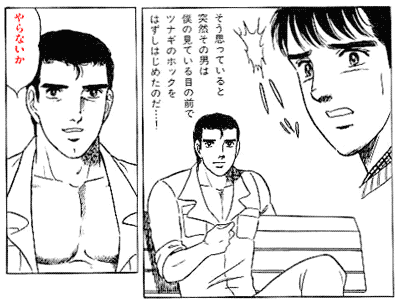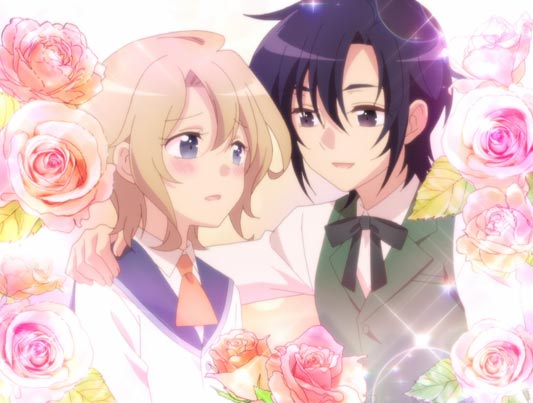In Japanese, bara 薔薇 means "rose," the flower. In the English anime fandom, bara typically refers to a genre of gay drawn pornography (hentai) featuring muscular, overweight, or hairy men. It's also spelled バラ, ばら.
Left: Lloyd Belladonna, ロイド・ベラドンナ
Anime: Tatoeba Last Dungeon Mae no Mura no Shounen ga Joban no Machi de Kurasu You na Monogatari, たとえばラストダンジョン前の村の少年が序盤の街で暮らすような物語 (Episode 9)
Rose
The word bara 薔薇 in Japanese normally means "rose," the flower. The term for the color "rose" would instead be:
- aka
赤
Red. - bara-iro
薔薇色
Rose-colored, as in having the color of a rose flower. - hada-iro
肌色
Skin-colored. - momo-iro
桃色
Peach-colored. - pinku
ピンク
Pink.
Kanji
The kanji of the word bara 薔薇 are uncommon, not part of the jouyou kanji 常用漢字, consequently, the word is sometimes spelled with katakana instead, as bara バラ.
Etymology
The origin of bara, "rose," is the word ibara 茨, "thorny shrub."(news.goo.ne.jp)
Gay Genre
The gay genre bara targets a male, homosexual audience, which makes it different from BL (yaoi やおい, shounen-ai), which are gay genres targeting a female, heterosexual audience.
Basically, BL is gay romance like in a shoujo 少女 manga, where girls are drawn beautifully, like princesses, and guys are drawn like princes, except the prince doesn't go after a princess, he goes after another prince, instead.
As a consequence of this art style, the male characters generally look like some super model, or lead singer of a popular boy band. Stylish, slender, no facial or body hair, is there to make the girls (or guys, in this case) hearts' flutter, going dokidoki, and so on.
Typically one guy is more feminine than the other, timid, shorter, weaker, crossdresses, or something like that, to make clear who is "guy" and the "girl," "top" and "bottom," seme and uke 攻め受け, of the gay couple.
By contrast, bara tends to be more manly in general, with body and facial hair, with muscles, body fat, and so on. It will avoid heteronormative stereotypes like there is a "girl" in a gay couple—it's two guys.
Right: Alex Louis Armstrong, アレックス・ルイ・アームストロング
Anime: Fullmetal Alchemist, Hagane no Renkinjutsushi 鋼の錬金術師 (2003) (Episode 30, Censored)
- Context: two manly men doing something lewd.
The best-known bara manga is probably the source of the yaranaika やらないか meme.
- Context: how very straight, I mean, direct of him.
- sou omotte-iru to
totsuzen sono otoko wa
{boku no mite-iru} me no mae de
tsunagi no hokku wo
hazushi-hajimeta no da...!
そう思っていると突然その男は僕の見ている目の前でツナギのホックをはずしはじめたのだ・・・!
While [I] was thinking like that, that man, in front of [my] eyes [while] {I was seeing [him]}, started undoing the hook of [his] jumpsuit. - yaranaika
やらないか
Won't [you] do [it]?
The term bara as a genre is normally only used in the English fandom. It seems this term exists in Japanese, too, but normally bara comics are instead called:
- gei komikku (geikomi)
ゲイコミック (ゲイコミ)
Gay comics. Gaycomi (abbreviation). - gei manga
ゲイ漫画
Nevertheless, gei manga and bii-eru manga BL漫画 are still different things, e.g. a girl won't like bara just because she likes BL.
Sometimes, BL is mistakenly thought of as synonymous with bara.
This happens because yuri 百合, "lily," is a lesbian genre.
BL stands for Boys' Love, so there's a derived counterpart for lesbian fiction called GL, Girls' Love, however, while gay fiction is normally called BL, lesbian fiction is normally called yuri, not GL.
This makes people assume that "lily" is some sort of flower language for GL, and that "rose" is a flower counterpart for BL.
- Context: Marutamachi Chika 丸太町ちか supports her friend's lesbian romance.
- {Maru-chan φ kaiteru} hon mo bara ka yuri ya mon na
マルちゃん描いてる本もバラかユリやもんな
[Well,] the books [that] {Maru-chan draws} is bara or yuri too, right?
- ya mon - same as da mono だもの, used to give a reason for something, in this case, it makes sense for Maru, who draws lesbian fiction, to be supportive of lesbian romance.
- autodoa de barasu na--
アウトドアでばらすなーー
Don't [tell everyone] outdoors!!- barasu - lexical causative verb for:
- bareru
バレる
For a secret to be exposed.
- bara? yuri?
ばら?ゆり?
Rose? Lily?- The friend doesn't know these weird flower-based terms!
Sometimes when you have a yuri-like scene with two girls in anime, lilies are drawn in the background.
Right: Kotoura Haruka 琴浦春香
Anime: Kotoura-san 琴浦さん (Episode 5, Censored)
Generally this only happens when a character is fantasizing about the relationship of two other characters. When it's two guys, and a fujoshi 腐女子 fantasizing about other characters' possible homosexual relationship, then roses are drawn in the background instead.
Right: Nicol Ascart, ニコル・アスカルト
Anime: Otome Game no Hametsu Flag Shika Nai Akuyaku Reijou ni Tensei Shiteshimatta…, 乙女ゲームの破滅フラグしかない悪役令嬢に転生してしまった… (Episode 3, Stitch)
- Context: roses are used in spite of such scenes being closer to BL, targeted at a female audience, than bara, targeted at a gay audience.
Genre Origin
Most likely, bara as a genre comes from the name of a certain gay magazine called bara-zoku 薔薇族, "rose tribe," first published in 1971.
This was the magazine where Kuso Miso Technique (the yaranaika manga) was published, for example.
According to its editor, the word bara was used because:(news.nicovideo.jp)
- Girisha shinwa ka nani-ka de "bara no shita de otoko doushi ga chigiri wo musubu" to iu hanashi ga aru
ギリシャ神話か何かで『薔薇の下で男同士が契りを結ぶ』という話がある
In Greek mythology or something like that there's a story saying "men exchange vows under a rose."
I'm not sure if he means this, but it could be in reference to King Laius who apparently had affairs with boys under rose trees. Although Laius is a well-known pederast that got cursed for raping one of his male pupils, I don't really know if he did such thing under a rose tree or not.
Historically, there have been some gay-related works created before bara-zoku with the word bara in their titles.(wdic.org)
- Bara no Souretsu 薔薇の葬列, Funeral Parade of Roses, is a 1969 movie related to gay culture.
However, I think it's more likely that both bara and yuri as genres originate from bara-zoku instead.
The magazine had a column for lesbian readers, called yuri-zoku no heya 百合族の部屋, "lily's tribe room," named such because lilies are the symbol of narcissism.(news.nicovideo.jp)
The term yuri 百合, "lily," is a genre of lesbian manga because of this. After all, this was where "lily" was first associated with female homosexuality in Japanese culture, so it's unlikely to have originated anywhere else.
It makes sense to think that, similarly, the reason gay-targeted fiction is called bara is also because of bara-zoku, and not because of some gay-related work that just happened to have the word "rose" in its title.
Presumably, the magazine published content for gays, including gay comics for gay men, consequently, gay comics became associated with the brand bara-zoku, and thus the term bara started being used to refer to them as a genre. The west loaned this terminology while Japan kind of forgot about it.
References
- 「いま気にかかっているのは少年愛のこと」ゲイ雑誌『薔薇族』の初代編集長 - news.nicovideo.jp, accessed 2021-05-26.
- 「百合」はなぜ、「百」に「合」という漢字なのか? 意外と知らない「花の名前」の由来をリサーチ - news.goo.ne.jp, accessed 2021-05-27.
- 薔薇 - wdic.org, accessed 2021-05-30.






No comments: